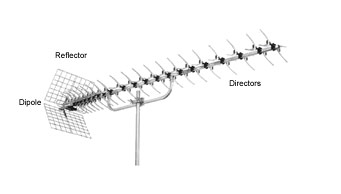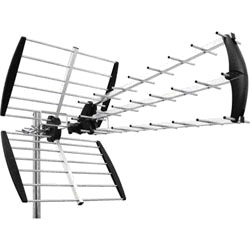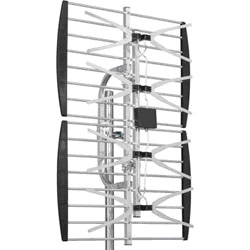Aerial Guide
A Guide to TV Aerials for Freeview HD
While many of us will happily spend thousands of dollars on a new television, there is a tendency to spend no more than absolutely necessary on the aerial installation. Particularly, with digital signals, optimizing your aerial can make a big difference to your viewing experience, doing a proper job of the aerial installation will ensure crystal clear reception without freezing or pixilation.
Signal Strength
Detailed coverage maps along with details about polarities for each transmitter are available below:
http://www.freeviewshop.co.nz/digital-terrestrial-i-8.html
The potential range of signal strengths available throughout New Zealand is huge. Some people live in such a poor area that even a high gain aerial grouped with a mast head amplifier will still not get them enough signal to receive Freeview HD. Others living within sight of a main transmitter may find they get a perfect picture with just a small aerial.
Thus, in order to choose the best aerial, it is very helpful to know the signal strength in your location. Ask yourself the following questions:
1. From the point where the aerial would be mounted, can you see the transmitter?
2. Do your neighbours get good signals and do they need amplifiers or high gain aerials to do so?
3. Are you up high or in a dip? The higher up you are the better your signal is likely to be.
4. How far away is the transmitter ?
5. Do you have obstructions between you and the direction of the transmitter ? Potential problems could be caused by hills, high buildings or trees. This is very important in determining the type of aerial you may require.
6. Do you have Prime and Maori TV analogue reception? If you do it is very likely that you will also receive the digital service if your reception comes directly from one of the Freeview HD transmitters.
Type of Aerial
X-Type
The majority of UHF aerials are X-Type type. These basically work by focusing the RF waves coming towards them on to the dipole. The latter is the driven element which actually receives the signal. All the other elements either act to focus the UHF signals or prevent unwanted UHF signals (from the rear) reaching the dipole.
X-Types are very directional and the Germans used similar aerials when they were attempting to detect Resistance radio operators in WW2. Operatives would be monitoring for any transmissions and by utilizing the directivity of the antennas they could plot which direction they were coming from!
As more elements are added to a X-Type aerial the acceptance angle narrows and the amount of signal received (the “gain”) increases. Gain is measured in decibels (dB) which measures the increase in signal received from an antenna compared to that which would be measured from just the dipole on its own.
X-Types are particularly suitable for line of sight applications.
Triple folding Structure
The triple folding structure aerial stacks three sets of directors one above the other and is particularly suitable in fringe reception areas where there is no direct line of sight as they are less directional than X-Types.
X-Type Magna Phased array
The X-Type Magna Phased array high gain aerial is not generally installed just to increase gain, it is used to overcome problems associated where obstacles are in the signal path. The phased array is four aerials linked together on to one down lead. This type of aerial has a very wide beam width so is particularly useful in overcoming problems where major obstacles are in the signal path.
Active Flat Panel Aerials.
Active flat panel aerials are a new type of aerial that has become available since digital terrestrial (Freeview HD) has started. They are active aerials that are provided with power by the Set Top Box or a power injector. They allow reception of Freeview HD with a very small aerial (compared with traditional aerials) but are suited for good to medium reception areas only.
Aerial Positioning
Aerial positioning can be of critical importance, particularly when anything is close to the aerial e.g., a chimney, trees or buildings. Freeview HD frequencies wavelengths are between 38cm and 56cm so moving an antenna a meter (vertically or laterally) can sometimes make a big difference to signal strength.
When it comes to aerial positioning a DIY installation can sometimes be more effective than a professional one. Why? Most installers do not take the time to experiment placing the aerial all over the house or try experimenting with the reception on different transmitters.
On the other hand, a DIYer is usually prepared to spend more time to get a great solution. You can also try tilting the aerial upwards at the front, it can sometimes make a worthwhile difference.
Most importantly is that line of sight is (almost) everything. Which transmitter have you got the clearest view of? This is far more important than which is the nearest.
Aerial Polarisation
You may have wondered why some aerials are mounted (or polarised) vertically and some horizontally. To work efficiently aerials must be polarised in the same plane as the transmitter they are receiving from. The reason for this use of vertical and horizontal polarisation is to take advantage of the fall off in response (to a signal of the opposite polarity) to minimize co-channel interference between the various transmitters. For example, the Sky Tower uses Vertical polarisation while Waiatarua uses horizontal polarisation.
Make sure to check you have the correct polarization here:
|





